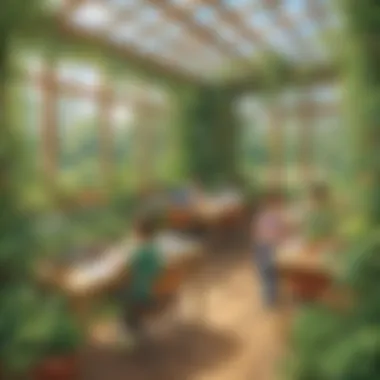Engaging Plant Projects for Elementary Students: Hands-On Botany Learning


Fun Activities Ideas
Engaging elementary students in plant projects can be a fun and interactive way to cultivate their interest in botany and nature. Through a variety of hands-on activities, children can explore the wonders of plant life while gaining valuable insights into environmental conservation. From indoor activities like seed germination experiments to outdoor adventures such as planting a garden, these projects offer a holistic approach to learning.
Indoor Activities
Indoor plant projects provide an excellent opportunity for children to witness the growth and development of plants up close. Seed germination experiments, where students plant seeds in containers and observe the stages of growth, can help them understand the life cycle of plants. Additionally, creating terrariums allows kids to build miniature ecosystems and learn about the importance of maintaining a balanced environment.
Outdoor Adventures
Taking plant projects outdoors can further enrich the learning experience. Planting a garden not only teaches children practical gardening skills but also instills a sense of responsibility towards caring for the environment. Exploring local flora and fauna on nature walks enables students to connect with the natural world and appreciate the beauty of plants in their native habitats.
Arts and Crafts
Incorporating arts and crafts into plant projects adds a creative element to the learning process. Children can make botanical-inspired artworks using leaves, flowers, or tree barks as materials. Creating plant-themed sculptures or collages encourages imagination and artistic expression while fostering a deeper connection to nature.
Science Experiments
Engaging in botany-related science experiments can help students develop critical thinking and analytical skills. Activities such as studying photosynthesis, conducting plant anatomy investigations, or exploring plant adaptations to different environments provide hands-on experiences that reinforce classroom learning and stimulate curiosity about the natural world.
Cooking and Baking


Integrating plant-based cooking and baking activities can enhance children's understanding of the relationship between plants and food. Growing herbs and vegetables in a school garden and using them to prepare simple dishes can offer valuable insights into nutrition and healthy eating habits. Baking plant-themed goodies like flower-shaped cookies or leafy cupcakes can make learning about plants a delicious and memorable experience.
Introduction
This article aims to showcase a variety of engaging plant projects tailored for elementary students, offering a unique blend of education and fun. By creating opportunities for children to explore seed germination, botanical art, and environmental conservation firsthand, we aim to inspire the next generation of environmental stewards.
Examining the key elements of the introduction, we emphasize the importance of providing holistic learning experiences that go beyond traditional classroom settings. By engaging children in practical activities such as seed germination experiments and eco-friendly planting initiatives, we foster a deeper connection to nature while instilling valuable skills in scientific inquiry and sustainability.
Moreover, the introduction sets the tone for the subsequent sections by highlighting the relevance of hands-on learning in enhancing children's comprehension and retention of botanical concepts. By connecting theory to practice, we bridge the gap between classroom knowledge and real-world applications, empowering students to become proactive participants in environmental conservation efforts.
Through a blend of informative content and actionable insights, this introduction paves the way for an enriching exploration of plant projects that promise to captivate and educate young minds while fostering a sense of environmental responsibility.
Seed Germination Projects
In this article focused on exploring engaging plant projects for elementary students, the section on seed germination projects holds significant importance. As an integral part of botanical studies, seed germination projects offer students a hands-on experience to learn about the life cycle of plants, understanding the crucial process from seed to sprout. By delving into seed germination, students can grasp fundamental concepts such as the role of water, light, and soil in plant growth.
Exploring Seed Growth
Exploring seed growth is a foundational aspect of plant projects for elementary students. This exploration allows young learners to witness the miraculous transformation of a tiny seed into a flourishing plant, instilling in them a sense of wonder and curiosity about the natural world. By observing the stages of seed growth – from seedling emergence to leaf development – students gain valuable insights into the plant life cycle and the factors that influence healthy growth.
Investigating Factors Affecting Germination


Investigating the factors affecting germination is a crucial step in seed germination projects for elementary students. By studying variables such as temperature, humidity, and soil quality, students can understand the optimal conditions required for seeds to sprout and grow. This hands-on investigation not only enhances their scientific knowledge but also encourages critical thinking and problem-solving skills as they analyze the impact of different variables on seed germination outcomes.
Designing Seed Germination Experiments
Designing seed germination experiments is a creative and engaging way to reinforce learning about plant growth processes. Students can design experiments to test hypotheses related to seed germination, exploring how factors like light intensity or seed depth influence plant development. Through designing and conducting experiments, young learners develop essential scientific inquiry skills and gain a deeper appreciation for the complexities of plant biology.
2. Botanical Art Projects
In the realm of elementary education, embracing Botanical Art Projects offers a unique avenue for students to meld creativity with scientific exploration. This segment within the article focuses on the significance of infusing art into plant studies, enabling young learners to appreciate the aesthetic beauty of nature while honing their observational skills. Through Botanical Art Projects, children embark on a journey that not only nurtures their artistic talents but also deepens their understanding of botanical elements.
Creating Plant Press Artwork
Delving into the realm of Creating Plant Press Artwork unlocks a world of artistic expression intertwined with botanical fascination. This particular subsection emphasizes the tactile experience of collecting and preserving plant specimens, encouraging children to observe intricate details that might otherwise go unnoticed. By pressing plant materials onto paper, students not only create visually appealing artwork but also develop a keen eye for botanical features and differences between plant varieties. This hands-on activity cultivates patience, attention to detail, and a profound appreciation for the plant kingdom.
Painting Plant Life
The practice of Painting Plant Life transcends ordinary art endeavors by inviting students to delve into the vibrant realm of botanical colors and shapes. Through this creative outlet, children not only explore their artistic abilities but also engage in a deeper exploration of plant structures and forms. Painting Plant Life fosters imagination as well as a deeper understanding of the nuances of plant anatomy, encouraging young artists to depict plant life with accuracy and finesse. This subsection combines artistic expression with botanical study, offering a holistic approach that stimulates both the creative and intellectual faculties of elementary learners.
Sculpting Botanical Models
Sculpting Botanical Models is a hands-on endeavor that merges artistic ingenuity with scientific acumen, allowing students to craft three-dimensional representations of botanical specimens. This subsection underscores the importance of tactile learning and spatial awareness as children mold clay or other materials into various plant forms. As students sculpt botanical models, they not only sharpen their sculpting skills but also deepen their understanding of plant structures and textures. This activity encourages creativity, spatial reasoning, and a profound connection to nature, enhancing students' appreciation for the intricacies of the plant world.


3. Environmental Awareness Projects
In this iteration of our article, we delve into the critical theme of environmental awareness projects designed to instill a sense of ecological responsibility in elementary students. The focus lies on fostering an understanding of the environment and empowering young minds to become stewards of the planet. Through these projects, children gain hands-on experience and develop a profound connection to nature.
Building Eco-Friendly Plant Containers
When it comes to building eco-friendly plant containers, the paramount consideration is sustainability. These projects offer students the opportunity to explore innovative ways of repurposing materials, emphasizing the importance of reducing waste and promoting eco-conscious habits. By constructing plant containers using recycled or biodegradable materials, children learn valuable lessons about resource efficiency and environmental impact. Moreover, they cultivate an appreciation for nature's cycles and the significance of adopting practices that support plant growth while minimizing harm to the ecosystem.
Planting Trees for a Greener Tomorrow
Planting trees serves as a cornerstone of environmental conservation efforts, symbolizing hope for future generations. This project educates students on the essential role of trees in maintaining ecological balance, enhancing air quality, and combating climate change. By engaging in tree-planting activities, children actively contribute to their community's green spaces, fostering a sense of pride and ownership in environmental preservation. They witness firsthand the positive effects of their actions, as saplings grow into towering trees that provide shade, habitat for wildlife, and oxygen for all living beings to breathe.
Organizing Community Planting Events
Community planting events offer a platform for students to expand their environmental impact beyond the classroom. By organizing and participating in such events, children not only strengthen their sense of civic duty but also cultivate invaluable social skills and teamwork. Collaborating with peers, parents, and local community members, students take part in larger-scale initiatives that promote biodiversity, beautify public spaces, and strengthen bonds within the community. These events create a ripple effect of positive change, inspiring others to join in the collective effort towards a more sustainable and harmonious coexistence with nature.
Conclusion
Specific Elements
The conclusion section encapsulates the essence of the article by emphasizing the practical applications and benefits of engaging in plant projects at a young age. By summarizing the hands-on activities discussed, ranging from seed germination experiments to environmental awareness initiatives, the conclusion underscores the holistic approach to learning that these projects offer. Through interactive experiences like creating terrariums and investigating seed growth, students not only gain botanical knowledge but also develop skills in observation, experimentation, and environmental stewardship.
Benefits
One significant benefit highlighted in the conclusion is the fostering of curiosity and environmental awareness in elementary students. By actively participating in plant-based projects, learners cultivate a deeper connection with nature, thereby instilling a sense of responsibility towards preserving the environment. Additionally, these projects promote creativity, critical thinking, and teamwork, ensuring a well-rounded educational experience for young minds.
Considerations about the Conclusion
When considering the conclusion of this article, it is essential to recognize its role in motivating ongoing engagement with plant projects beyond the classroom. Encouraging further exploration and application of the concepts learned through these projects can lead to a sustained interest in botany and conservation. The conclusion acts as a springboard for continued learning and practical involvement, inspiring students to carry forward their environmental consciousness and passion for plants into the future.



